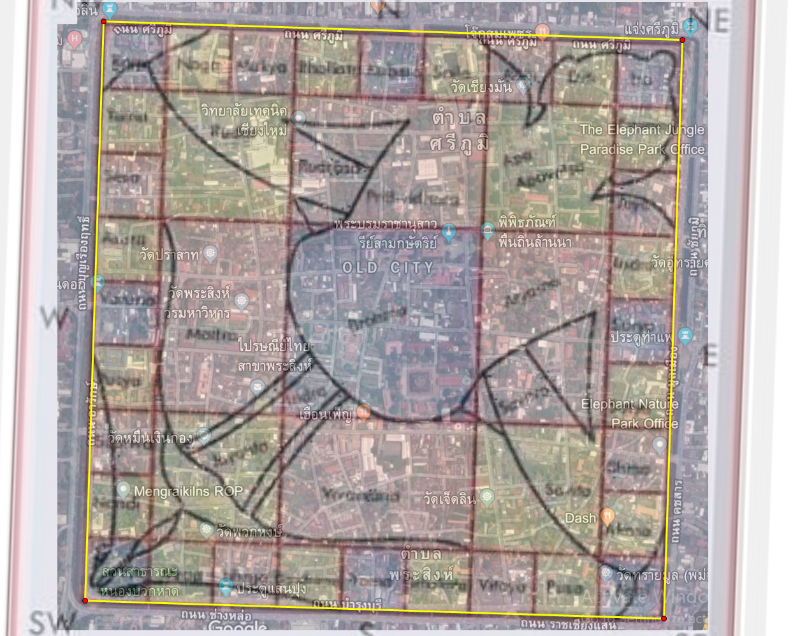The Off-cardinal Alignment of Chiang Mai’s City Plan in Relation to the Orion’s Belt
Main Article Content
Abstract
Chiang Mai, the largest city in northern Thailand, was once the capital of the ancient Lanna kingdom, founded by King Mangrai on 19 April 1296 (Gregorian). The historic city plan, which may have been influenced by Vaastu Shastra (an ancient Hindu knowledge of architecture), features almost a square shape with each side length ranging from 1.52 -1.57 kilometers, bordered by four walls facing the cardinal directions. However, a careful examination reveals that the east-west orientation of the city plan is tilted southeastward with an azimuth of 92.5°, prompting further investigation as to which method was used in the city’s orientation. Historically, two ways to lay out the directions were via the gnomon, such as the shortest shadow and the Indian circle methods, and via fixed stars. In this work, we carried out year-long measurements of the shortest shadow and the Indian circle methods and discovered that neither resulted in an error greater than 0.7°, allowing us to consider the orientation method as being associated with specific fixed stars. A theodolite and a GPS were used to identify the orientation axis along the northern city wall, calibrated using the positional astronomy program Stellarium. Using precession-corrected Stellarium, the ancient sky can be simulated to uncover the aligned star at the same azimuth as Mintaka (δ Ori) in the Orion’s Belt at a height of 4° and possibly Alnilam (ε Ori) at a height of 1.5° (under an apparent sky condition) during the period between 1292 and 1296, which is close to when King Mangrai founded the city.
Article Details

This work is licensed under a Creative Commons Attribution-NonCommercial-NoDerivatives 4.0 International License.
References
Wichienkaeo, A.; Wyatt, D. K. The Chiang Mai Chronicle. Chiangmai: Silkworm Books; 1995. (in Thai)
Princess Maha Chakri Sirindhorn Anthropology Centre. Wat Chiang Man Inscription Face I 2021. https://db.sac.or.th/inscriptions/inscribe/image_detail/26515 (accessed June 4, 2023).
Saelee, C.; Riyaprao, O.; Komonjinda, S.; Sriboonrueang, K. An archaeoastronomical investigation of vaastu shastra principles (vedic architecture) implemented in the city planning of ancient Chiang Mai. In: Orchiston, W.; Vahia, M. N., editors. Exploring the History of Southeast Asian Astronomy: A Review of Current Projects and Future Prospects and Possibilities, Cham: Springer, 2021; 461–485. https://doi.org/10.1007/978-3-030-62777-5_13.
Sastri, V. S.; Bhat, W. M. R. Varahamihira’s Brihat Samhita: with an english translation and notes. Bangalore: V.B. Soobbiah & Son; 1946.
Yano, M. Knowledge of Astronomy in Sanskrit Texts of Architecture (Orientation Methods in the īśāna śiv a gurudev apaddhati). Indo-Iranian Journal, 1986; 29. https://doi.org/10.1163/000000086790082163.
Kramrisch, S. The hindu temple: volume one. Delhi: Motilal Banarsidass Publ.; 1976.
Komonjinda, S.; Riyaprao, O.; Sriboonrueang, K.; Saelee, C. Relative orientation of Prasat Hin Phanom Rung Temple to Spica on New Year’s Day: the chief indicator for the intercalary year of the luni-solar calendar. Proceedings of the International Astronomical Union, 2019; 15, 260–264. https://doi.org/10.1017/S1743921321001034.
Riyaprao, O.; Sriboonrueang, K.; Komonjinda, S.; Saelee, C. Astronomical Orientation of Phra That Doi Suthep Temple in Relation to Acronychal Rising of Corona Borealis and Visakha Bucha Day. Journal of Astronomical History and Heritage 2023; (in press).
Espenak, F. Delta T (ΔT) and Universal Time, 2011. https://eclipse.gsfc.nasa.gov/SEhelp/deltaT.html (accessed September 10, 2023).
Espenak, F.; Meeus, J. Five Millennium Canon of Solar Eclipses: -1999 to +3000, 2006. https://eclipse.gsfc.nasa.gov/SEpubs/5MCSE.html (accessed September 9, 2023).
Burgess, E. Translation of the Surya Siddhanta. Delhi: Indological Book House; 1977.
Ammarell, G.; Tsing, A. L. Cultural Production of Skylore in Indonesia. Handbook of Archaeoastronomy and Ethnoastronomy, New York, NY: Springer New York; 2015; 2207–2214. https://doi.org/10.1007/978-1-4614-6141-8_236.
Thom, A. Megalithic Sites in Britain. Oxford: Clarendon Press; 1967.
Gislén, L.; Eade, J. C. The Calendars of Southeast Asia. 4: Malaysia and Indonesia. Journal of Astronomical History and Heritage, 2019; 22, 447–57.


